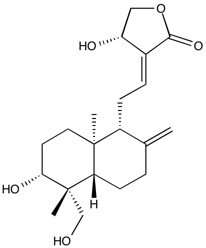Andrographolide | Induces mitochondrial-mediated apoptosis
NMR (Conforms)

Available Options
| size : | Price | Quantity | |
|---|---|---|---|
| 100 mg | $34.00 | ||
| 500 mg | $136.00 |
Andrographolide (5508-58-7) is the major bioactive component of the medicinal plant Andrographis paniculate. Demonstrates anti-inflammatory anti-apoptotic, anti-viral and anti-proliferative effects in vitro and in vivo. Prevents hyperglycemia in rat diabetes model. Andrographolide is an irreversible antagonist of NK-κB and AP-1 (IC50 = 15 μM)
References/Citations:
1) Xia et al. (2004), Andrographolide attenuates inflammation by inhibition of NF-kappa B activation through covalent modification of reduced cysteine 62 of p50; J. Immunol., 173 4207
2) Chen et al. (2004), Andrographolide suppresses endothelial cell apoptosis via activation of phosphatidyl inositol-3-kinase/Akt pathway; Biochem. Pharmacol., 67 1337
3) Yu et al. (2003), Antihyperglycemic effect of andrographolide is streptozotocin-induced diabetic rats; Planta Med., 69 1075
NMR (Conforms)
Safety Data Sheet:
Product Data Sheet:
Materials provided by Focus Biomolecules are for laboratory research use only and are not intended for human or veterinary applications. Please note that we do not sell to individuals and that all orders placed by non-research organizations will incur a $20 restocking/refund fee
Andrographolide (5508-58-7) is the major bioactive component of the medicinal plant Andrographis paniculate. Demonstrates anti-inflammatory anti-apoptotic, anti-viral and anti-proliferative effects in vitro and in vivo. Prevents hyperglycemia in rat diabetes model. Andrographolide is an irreversible antagonist of NK-κB and AP-1 (IC50 = 15 μM)
References/Citations:
1) Xia et al. (2004), Andrographolide attenuates inflammation by inhibition of NF-kappa B activation through covalent modification of reduced cysteine 62 of p50; J. Immunol., 173 4207
2) Chen et al. (2004), Andrographolide suppresses endothelial cell apoptosis via activation of phosphatidyl inositol-3-kinase/Akt pathway; Biochem. Pharmacol., 67 1337
3) Yu et al. (2003), Antihyperglycemic effect of andrographolide is streptozotocin-induced diabetic rats; Planta Med., 69 1075
Related NFκB Products
Download
Calculate the molar concentration, mass or volume in a solution.
Concentration × Volume × Molecular Weight = Mass
Focus Biomolecules • Plymouth Meeting, PA USA • 1-855-FOCUS21
Focus Biomolecules
Plymouth Meeting, PA USA
1-855-FOCUS21
Website Created by Advanta Advertising LLC.

